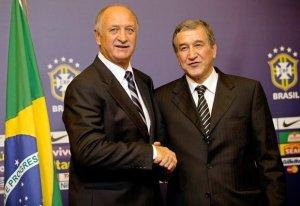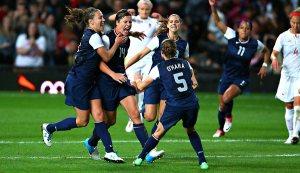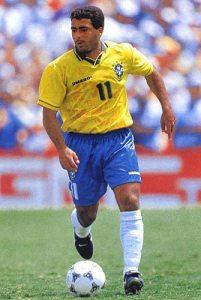
Felipão & Carlos Alberto Parreira (mail.com)
Our Day Will Come
With Luiz Felipe Scolari, 64, better known to soccer fans as Felipão (or Big Phil), returning as head coach, and former coach Carlos Alberto Parreira (five years younger than Scolari) being appointed as technical director, Brazil’s National Team received a much needed jolt of excitement into the upcoming 2014 World Cup Finals, to be held in Brazil for only the second time in football history.
As an added bonus, I will be re-running a series of articles I wrote a few seasons back about soccer’s rise in the United States, along with my previous 2006 World Cup Soccer coverage – the less said about Brazil’s disastrous 2010 non-performance, the better.
So here you go, soccer fans! Score one for our side!!! And may the best (ha-ha) team win.
To Broil and Play in L.A.
At the Rose Bowl Stadium in Pasadena, California, two rival forces were vying with each other for bragging rights as to who would come out on top of a month-long sports tournament that seemed to verge on the interminable.
The temperature on the playing field that scorching Sunday afternoon in mid-summer soared to a sizzling 100 degrees Fahrenheit. There wasn’t a shady spot to be had anywhere, and most definitely not in the stands, where over 90,000 sunbaked and dehydrated sports fans nervously awaited the outcome of the decisive game.
From the air-conditioned comfort of my fifth-floor living quarters in New York City, I too agitatedly witnessed this sweltering spectacle on live network television, alongside my Brazilian-born wife, my two school-age children, and my invited guests.
Obviously, this was not some leftover Super Bowl halftime activity, nor was it an outdoor track and field event from the Summer Olympic Games. This happened to be the final contest in the 1994 World Cup Soccer Championship between three-time titleholders Italy and Brazil, two ancient combatants of this mighty “kicking game,” and two countries that have partaken of a customary Latinate pride and Continental code of honor with regard to their illustrious past soccer accomplishments.

Roberto Baggio’s missed penalty kick (soccerplusnet.blogspot.com)
Unfortunately for the Italian side, its last and best hope for total team victory abruptly ended in crushing defeat, thanks to Roberto Baggio’s miraculously misdirected penalty kick (purportedly diverted by Divine Providence, some wags would say).
As the overflow crowd heaved a collective sigh of relief, the jubilant Brazilians bounded onto the playing field and gave thanks to the goddess Fortuna for having granted them the special favor of a belated, and unprecedented, fourth World Cup.
It was the epitome of market strategy and maneuvering in this country, the crowning achievement of soccer in America, to have the International World Cup Soccer finals held on North American soil for the first time in its history. A previous attempt at staging the games here in 1986 was rudely quashed by the International Football Association Federation, or FIFA, the governing arm of world soccerdom, with the main reason given as “a lack of commitment” on the part of the paying public and the sport’s domestic sponsors.
But as the congenial host country for this most highly-publicized and anticipated of all international sporting events, America had acquitted itself admirably enough, considering that the U.S. national team miraculously survived first-round play, only to be ousted in the second round by heavily favored Brazil on a lone, game-winning goal by the speedster Bebeto.
Futebol Scores Big in America
Instead of an untimely end to soccer’s bold advance, it was barely the beginning of a steady surge in America of this emotionally charged spectator sport, a literal rising tide that has gained noticeably in force and momentum — and national acceptance — over the 15-year period since the quadrennial event was first held here.
And what better evidence of this progress in the field than the impressive Team USA performance at the 2002 World Cup matches in South Korea, where it toppled the highly regarded Portuguese by a score of 3-2, then stunned early morning viewers with an equally sensational 2-0 triumph over Mexico, only to lose out 1-0 in the quarterfinals to the much stronger German squad.*
Indeed, the current popularity in America of the “beautiful game,” in a nation that has owed much of its very existence to the hard work and sinewy strength of her huddled ethnic masses — who were first credited with having brought the alien sport to these formidably unfriendly shores some 200 or so years ago — was certainly a long time in coming.
But like many foreign imports, such as the German Volkswagen Beetle or the Japanese transistor radio, the blue-collar, working-class game of futebol (as Brazilians often refer to it) had dared to compete directly in the mid– to late ’70s with the other, more traditional television-viewing pastimes, i.e., Major League Baseball, NBA Pro Basketball, and Monday Night Football; in the process, it had deliberately set itself up for a precipitous fall from TV-ratings grace.
Despite the almost insurmountable obstacles the sport has had to overcome since then; amid the often-times antagonistic competition offered by this delectable garden of armchair delights, soccer has held firm to the cause by ingratiating itself with young and old alike. It has survived, relatively unscathed, its initial battle for media attention, to re-surface in more modest middle-class surroundings as the playground game of choice.
From those heady early times, soccer in the U.S. has continued to expand beyond state boundaries and exceed all previous low expectations, as more and more of the nation’s athletic directors have become enthralled by the game, and ever more willing to push for it.
Almost 20 years ago, it was estimated that approximately eight million Americans had played some form of the sport (all figures compiled by the United States Soccer Federation and the YMCA); by the late 1990s, over seventeen million had actively participated in the game, from the enthusiastic junior and youth levels up to and including college varsity play.
There are now over 70 indoor and outdoor soccer franchises scattered throughout the continental United States, and the numbers continue to grow with each passing year. Even the words “soccer mom” have become as fashionable and familiar a term in the everyday lexicon of English usage as “baby boomer” and “couch potato” have been. They define the very image of a harried suburban housewife, trotting her snotty seed off to scrimmage practice.
With the yearly hike in soccer participation appearing to have brought about a somewhat more favorable turnaround in the fortunes of the sport — perhaps heralding a mass cultural phenomenon still to be corroborated by more current quantifiable data — the demise of the Women’s United Soccer Association (WUSA) in September 2003, after only three short seasons of unprofitable operation, has put but a small dent in this steady upward trend.
Practice Makes Brazil Perfect (Well, Maybe)

USA Women’s Team (Doug Mills / NY Times)
While soccer in North America can resolutely boast of some successful outward signs of positive growth, and has even experienced a semi-reasonable facsimile of media mega-blitz, especially concerning the press coverage allotted women superstars Brandi Chastain, Mia Hamm, Hope Solo, Tiffeny Milbrett, and Abby Wambach (albeit, in much more constrained form here than in other soccer-crazed countries), all was not going as well as it should have for the sport in the land of Carnival.
In spite of its premier ranking (followed closely by France and Spain), the five-time world champion Brazilian national team had so far performed perfunctorily, if rather unremarkably, in a series of friendlies and World Cup qualifying matches, and against some low-rated international competition.
The Brazilian players’ cavalier attitude toward simple physical exertion has sometimes bordered on the lethargic and driven over-eager World Cup watchers, such as myself, to near frenzied distraction by the team’s diversionary tactics.
In more distant soccer days, this slower-paced style of play was once looked upon as a source of national pride, with the national team performing a sort of quasi-mystical field combination of soccer mixed with samba. Today, the fast-break techniques of most European soccer teams tend to leave behind many of the second-string Brazilian players, many of who are not used to stretching themselves so in their own country’s more tropical climate.
Other higher-priced starters — Ronaldinho Gaucho, Ronaldo, Rivaldo, Roberto Carlos, Cafu, and rising star Kaká — were more conformed, for the most part, to this rapid-fire running mode than their lower-salaried counterparts, since all of them played in the European leagues, another break with the traditional past. This clash of personal playing styles (and forms of monetary compensation) inescapably leads to frustration and resentment on the part of both players and coaches over the direction the national team should take regarding international combat duty. In addition, much needed practice time is invariably limited or lost due to the differing playing schedules of many of the European clubs versus the national team’s own training requirements.
These are far from new wrinkles in the Brazilian team fabric, mind you, just old war wounds and festering sores that continue to rankle and that will require more immediate attention.
How the Mighty Corinthians Had Fallen
The abandonment by native Brazilian talent for richer, more financially fertile soccer plains abroad has even pervaded the ethos of my own favorite local team, São Paulo-based Sport Club Corinthians Paulista.
A three-time winner of the Brazilian national crown, and a keeper of the country’s second largest and most vocal fan base (behind Rio de Janeiro’s Flamengo), Corinthians was clobbered 6-1, in late September 2003, in what can only be politely described as an “historic” encounter.
By the widest margin in the team’s history, it lost an embarrassingly one-sided fray against upstart Juventude, after a fog-enshrouded cover had descended upon the dampened enemy camp, blanketing the players with an impenetrable and, as it turned out, faintly portentous mist of near-Shakespearean proportions. Upon the culmination of this patently horrific display, head coach Geninho promptly quit the club, refusing to answer reporters’ queries, or even justify his spontaneous action — as if it needed any defense.
In despair, the club turned to legendary World Cup star Roberto Rivellino, a former Corinthians player-turned-television sportscaster, to manage the team from the technical side, together with a new field commander, ex-national team member Júnior.
After a trying week, the hapless Júnior became the next casualty of the club’s unlucky losing streak, as his campaign for all-out conquest all-but ended with two more devastating defeats: the first, against São Caetano, in his maiden appearance as técnico (or “coach”); and the second, a heart-breaker to arch-rival São Paulo, and by the same depressing 3-0 tally.
As the sole survivor of this carnage, the bloodied but unbowed Rivellino had his hands full trying to recover sufficient enough ground to qualify Corinthians for the 2004 Libertadores Cup (highly remote, as it turned out). One of his biggest challenges was to find suitable replacements for his top-seeded starting lineup, many of who had already defected to other teams or had been sold off to foreign clubs in Lisbon, Istanbul, and Hanover, prior to Geninho’s precipitate departure, as a stopgap measure concocted by Corinthians for raising much-needed capital.
Judging from all of this, it is hard to believe that the same team had once won the coveted FIFA 2000 World Club crown, not to mention 2002’s prestigious Copa Brasil and Paulista championships. And before them, all Brazil trembled!
Romário to the Rescue?

Romario (footballers-info.blogspot.com)
Speaking of which, let us not forget the latest nefarious misdeeds (via the infamous “chicken incident,” wherein an overly enthusiastic fan expressed his low opinion of the player’s performance by throwing six live hens at him) attributed to the sport’s clown prince and prima donna of the playing field, the Mike Tyson of professional futebol: Fluminense’s own Romário.
His rambunctious, bully-boy attitude, loopy rock-star lifestyle, and hair-trigger temper tantrums notwithstanding, this one-man demolition derby went on to score the only goal against the sad-sack Corinthians troop. No matter, as flustered Fluminense fans still had to face the likelihood of their team being banished to the ignoble second division, if it had continued on its then-current downward course.
Ironically, the flamboyant Romário was at one time the main attraction of the 1994 World Cup Brazilian national squad (along with fellow teammate Bebeto), and the raison d’être for its record-breaking victory performance. Despite this formidable field reputation, however, he was officially dismissed from the 1998 team due to a pulled calf muscle. But the unofficial word had it that he and national team coach Mário Zagallo simply could not get along with each other, ergo out he went. A pity, since his absence had been given as one of the main causes for Brazil’s 3-0 loss to France.
How much sparkle and élan O Pequeno Príncipe (“The Little Prince,” with appropriate apologies to the Marquis de Saint-Exupéry) still has left in reserve, after several eventful years atop the profession’s upper echelon, remains to be seen. Nevertheless, the trouble-making player-cum-prankster may still have a few hat tricks up his metal cleats, and his future most earnestly bears watching — if he can keep himself from self-destructing beforehand.
Perhaps Corinthians could have made better use of his talents, which would not have hurt the club’s chances in the least, nor put them in any worse position than they were already in.
Soccer Scrutiny Requested
All of these fascinating turns of soccer events in the United States and Brazil — in a sport once relegated here to the lowest rung on the financial ladder of American athletic programs, but given far too expansive a coverage (and frequent overexposure) in South America’s largest country — scream for closer examination.
Not surprisingly, there are no simple answers as to why the game of soccer has gained such a strong foothold on the Northern Hemisphere, only to begin to lose its all-encompassing grip and, more importantly, its pride and self-respect in the Southern one.
As a result, soccer will continue to score big with U.S. sports fans, while it could conceivably amble on, indefinitely, in comparative malaise in Brazil, the very place where the game had previously outshone all others. It should, by all rights, privileges, and historical precedents, continue to do so, once it’s finally learned what is truly ailing it.
Unfortunately, the actual long-term treatment and prognosis for Brazilian soccer’s many ills may prove to be much more problematic to minister to and manage than was originally thought. Indeed, only time will tell. ☼
(End of Part One)
Copyright © 2010 by Josmar F. Lopes
* At the June 2009 FIFA Confederations Cup semifinals in South Africa — a preliminary run for the 2010 World Cup Soccer tournament in the same country — Team USA shocked the sports establishment with a 2-0 victory over top-ranked Spain, “the best team in the world,” according to New York Times sportswriter George Vecsey. In the final match-up against Brazil, however, it took an early 2-0 lead at the half, only to give up three consecutive goals to the never-say-die Brazilians, who went on to win their third consecutive crown.

